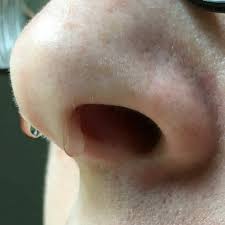 Rhinorrhea is the free discharge of a thin nasal mucus fluid.
Rhinorrhea is the free discharge of a thin nasal mucus fluid.
Commonly known as a runny nose.
Occurs relatively frequently.
A common symptom of allergies, and viral infections, such as the common cold.
May manifest with crying, exposure to cold temperatures, cocaine abuse, opioid withdrawal or head trauma.
Treatment for rhinorrhea is not usually necessary.
Characterized by an excess amount of mucus produced by the mucous membranes that line the nasal cavities.
Mucous membranes create mucus faster than it can be processed, causing an accumulation of mucus in the nasal cavities.
As the nasal cavities fill up, it blocks off the air passageway, causing difficulty breathing through the nose.
Air and fluid caught in the sinus cavities, cannot be released and the resulting pressure may cause a headache or facial pain, and eventually sinusitis.
Mucus that backs up through the Eustachian tube, may result in ear pain or an ear infection.
Excess mucus May accumulate in the throat or back of the nose causing post-nasal drip, resulting in a sore throat or coughing.
Rhinorrhea symptoms include sneezing, nosebleeds, and nasal discharge.
Cold-induced rhinorrhea is due to a combination of thermodynamics and the body’s natural reactions to cold weather stimuli.
Nasal mucus warms inhaled air to body temperature as it enters the body.
Nasal cavities must be constantly coated with liquid mucus.
With a cold and dry environment,
the mucus lining nasal passages tend to dry out, and the mucous membranes overproduce mucus to keep the cavity lined.
The nasal cavity can then fill up with mucus.
When air is exhaled, water vapor in breath condenses as the warm air meets the colder outside temperature near the nostrils, causing an excess amount of water to build up inside nasal cavities.
The excess fluid usually spills out externally through the nostrils.
Rhinorrhea can be a symptom of other the common cold or influenza patients infections, with the nasal mucous membranes producing excess mucus, and filling the nasal cavities.
Mucus production prevents infection from spreading to the lungs and respiratory tract.
Rhinorrhea caused by these infections usually occur on circadian rhythm basis.
Over the course of a viral infection, sinusitis may occur, causing the mucous membranes to release more mucus.
Rhinorrhea can also with allergies to pollen, dust, latex, soy, shellfish, or animal dander.
Inhalation of one of these substances triggers the production of the antibody immunoglobulin E (IgE), which binds to mast cells and basophils, causing the release of inflammatory mediators such as histamine.
The above causes inflammation and swelling of the tissue of the nasal cavities as well as increased mucus production.
Rhinorrhea is also associated with shedding of tears (lacrimation), whether from emotional events or from eye irritation.
With the production of excess tears, the liquid drains through the inner corner of the eyelids, through the nasolacrimal duct, and into the nasal cavities.
With shedding of tears, more liquid flows into the nasal cavities, stimulating mucus production and hydrating any dry mucus already present in the nasal cavity.
The buildup of this fluid is usually resolved via mucus expulsion through the nostrils.
A basilar skull fracture can result in a rupture of the barrier between the sinonasal cavity and the anterior cranial fossae or the middle cranial fossae, allowing the nasal cavity to fill with cerebrospinal fluid: cerebrospinal fluid rhinorrhea or CSF rhinorrhea, can lead to a number of serious complications and possibly death if not addressed properly.
Rhinorrhea can occur as a symptom of opioid withdrawal accompanied by lacrimation.
It can be a symptom of exercise-induced rhinitis, cystic fibrosis, whooping cough, nasal tumors, hormonal changes, and cluster headaches.
It is as a frequent side effect of oxygen-intubation during colonoscopy procedures.
It can also be the side effect of genetic disorders: primary ciliary dyskinesia.
Treatment for rhinorrhea is not necessary, in most cases, since it resolves on its own: especially if due to an infection.
